中职英语基础模块上册unit
中职英语基础模块上册Unit_1单元测试题
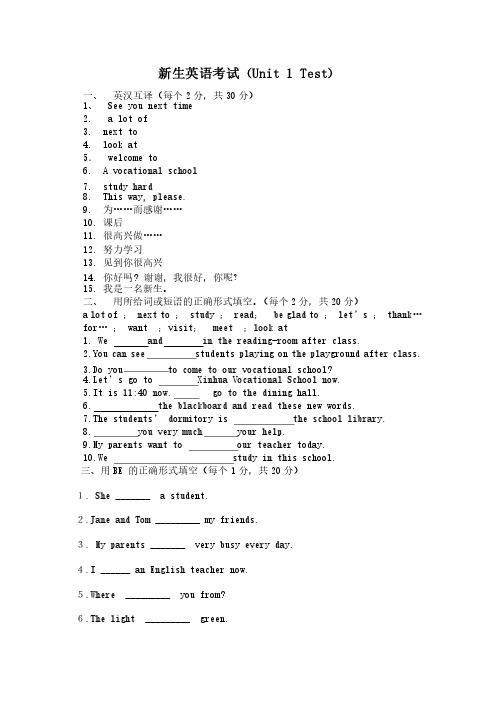
新生英语考试(Unit 1 Test )一、一、 英汉互译(每个2分,共30分)分)1、 See you next time2. a lot of3. next to4. look at5. welcome to6. A vocational school7. study hard8. This way, please.9. 为……而感谢……为……而感谢……10. 10. 课后课后课后11. 11. 很高兴做……很高兴做……很高兴做……12. 12. 努力学习努力学习努力学习13. 13. 见到你很高兴见到你很高兴见到你很高兴14. 14. 你好吗你好吗你好吗? ? ? 谢谢,我很好,你呢?谢谢,我很好,你呢?谢谢,我很好,你呢?15. 15. 我是一名新生。
我是一名新生。
我是一名新生。
二、二、 用所给词或短语的正确形式填空。
(每个2分,共20分)分)a lot of of ;; next to to ;; study study ;; read read;; be glad to to ;; let let’’s s ;; thank thank……for for…… ; want want ;;visit visit;; meet meet ;;look at1. We and in the reading-room after class.2.You 2.You can can see students see students playing playing playing on on the the playground playground playground after after after class. class.3.Do you to come to our vocational school?4.Let 4.Let’’s go to Xinhua Vocational School now.5.It is 11:40 now. go to the dining hall.6. the blackboard and read these new words.7.The students 7.The students’’ dormitory is the school library.8. you very much your help.9.My parents want to our teacher today.10.We study in this school.三、用BE BE 的正确形式填空(每个的正确形式填空(每个1分,共20分)分)1. She _______ a student.2.Jane and Tom _________ my friends.3. My parents _______ very busy every day.4.I ______ an English teacher now.5.Where _________ you from?6.The light _________ green.7.My name _________ Li Dong.8._________ they your new friends?9. The girl______ Jack's sister.1010. ______ your brother in the classroom? . ______ your brother in the classroom?1111. Whose dress ______ this? . Whose dress ______ this?1212.That ______ my red skirt. .That ______ my red skirt.1313. Some tea ______ in the glass. . Some tea ______ in the glass.1414.Gao shan's shirt _______ over there. .Gao shan's shirt _______ over there.1515. ______ David and Helen from England? . ______ David and Helen from England?1616. . There ______ some milk on the table . And there _______ any _______ any coffee coffee here .1717. There ______ a newspaper in the living room. . There ______ a newspaper in the living room.1818. ______ there any books in the room? Yes, there ______ . . ______ there any books in the room? Yes, there ______ .1919. There ______ a pencil, a ruler and two books on the desk. . There ______ a pencil, a ruler and two books on the desk.2020. There ______ two glasses and a cup on the table. . There ______ two glasses and a cup on the table.四、句型转换(每个2分,共20分)分)1. There is a teacher in the office . 否定句否定句 ________________________ ________________________2. Is there a flower on the table ? 肯定回答肯定回答____________ ____________肯定句肯定句 __________________ __________________3. There are some pens in the box . . 一般疑问句一般疑问句一般疑问句 __________________________ __________________________4. There isn isn’’t any water in the galss . . 肯定句肯定句肯定句 ________________________ ________________________5. There are two eggs and one cake here . 对划线部分提问对划线部分提问_______________________6. What 6. What’’s on the box ? (a present) s on the box ? (a present) 回答问题回答问题回答问题_______________________________7. How many books are there on your desk ? 回答问题回答问题___________________________8. There is a bird in the tree . 8. There is a bird in the tree . 对划线部分提问对划线部分提问对划线部分提问_________________________________9. There are lots of people in the park . 对划线部分提问对划线部分提问____________________________10. There is some water in the glass . 对划线部分提问对划线部分提问____________________________一般疑问句并回答一般疑问句并回答一般疑问句并回答 _________________________________ _________________________________否定句否定句否定句______________________________________________________________五、阅读题(五、阅读题(1010分)分)No.4 middle School Kunming ,yunnan April 2nd ,2004 Dear editor (编辑) ,I live in a beautiful city . Many visitors come to my city . there are so many colorful peacocks (孔雀) here . The peacocks mostly live on the grass land of Dongfeng Square They are given food freely by visitors . They usually throw food to them , and don’t think about at all whether the food is right or not . Some of the peacocks became ill , some even died after eating the bad food given by the visitors. I’m sure most of the visitors who throw foo d to the peacocks really like the birds , but don’t realize (意识到) that they may be doing them harm (伤害). The visitors should be told that what have done is very harmful to the birds , and this kind of thing must be stopped from happening . Perhaps we can build some small shops beside Dongfeng Square to sell peacock food . For us every person , it’s our duty to give more love to these beautiful birds and to look after them carefully. Yours, Sun Y an ( ) 6.Many visitors come to the writer’s city to __________. A.do some shopping B. see beautiful peacocks C. play on Dongfeng square D. eat nice food ( ) 7.Some peacocks became ill and died because some visitors ______; A. did’t give them any food B. gave them too much food C. threw them some bad food D. loved them and played with them( ) 8.Some shops can be built beside Dongfeng Square so that they may _____________. A.sell food for visitors B. sell food for peacocks C.make the square more beautiful D.have the beautiful birds ( ) 9.From the passage we know people should __________. A. live and play with the birds B. stop the birds from eating too much C. give right food to the birds D. give more food to the birds( ) 10.We can guess the writer of the letter, Sun Yan , may be a _____. A. visitor B. shopkeeper C.square keeper D. student 。
语文版中职英语基础模块上册1-6单元 必背语法(含短语与句型)

26.Howlarge it is!(它)好大啊!(how修饰形容词或副词)
Whatterrible news!多么可怕的消息(what修饰名词)
27.many students 很多学生(many只能修饰可数名词)
28.play basketball/football打篮球/踢足球(球类名词前无冠词)
3.a picture of my family一张我的家人照
in the picture 在照片里面
4.overseventy70多岁
5.Bothof...are...两个...都....
6.对...和蔼(友善)
It’s very kindofyou to do... ...你真好
16.dream to bea doctor梦想成为一名医生
17.be fullof充满...⇒be filled with 充满...
18.Behind my grandmother ismy mother.我妈妈在我奶奶身后。
(地点短语放句首的倒装)
On the right of my father standsa handsome young man.
关键词用法
1.concern关心
show great concern about... 很关心...
2.Haidian Vocational School海淀职业学校
3.learn Chinese cooking学习中国菜
cooking 饭菜,烹饪
French/home cooking 法国/家常菜
14.be popularwith受...的欢迎
15.ontheright (of)在...的右边
中职基础模块Unit1
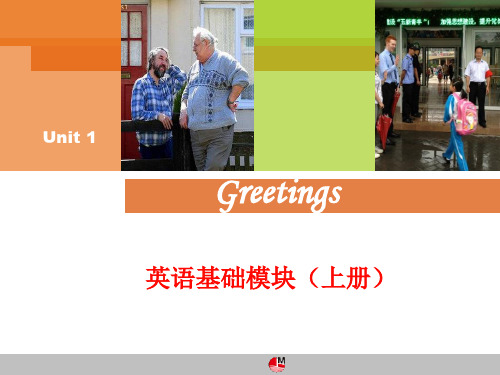
Warming up
Unit 4
What are you going to say ?
Warming up -Good morning.I’m Wang Yan.
-Good morning.Miss Wang.
Unit 4
-Hello,Jim! How are you? -Fine, thank you,Li Lei.And you? -I’m fine, too.Thank you.
Where can you go after class?
Welcome to Our School
Reading
Unit 4
Large and bright
50 students
Welcome to Our School
Reading
Unit 4
4 reading rooms
School library
Yang Quan Sports School
Look, this is the classroom building of our school. There are sixty classrooms, eighteen labs and many teachers‘ rooms in this building. Our classroom is on the third floor. It is large and bright. There are fifty students Unit in our 4 class. That building is the school library. It is a new building. There are a lot of books in it. There are four reading rooms inthe library. We can read and study in the reading rooms after class. 翻译:瞧,这就是我们学校的教学楼。里面有60间教室, 18个实验室和许多教师办公室。我们的教室在3楼。既明 亮又宽敞。我们班有50人。那栋楼是学校图书馆。是新建 的。里面有很多书。图书馆有4间阅览室。下课后,我们 可以到阅览室里阅读和学习。
中职英语基础模块上册unit1PPT课件

I'm fine,too.Tha
nk you! 我也是,谢谢
LOREM IPSUM DOLOR
Nice to meet you! 很高兴见到你 Nice to meet you,too! 也很高兴见到你
• Notes:
•
• 1. Introductions are important because a proper introduction will leave a good first impression upon others.
Between Acquaintances [ə´kweıntəns ]
Hello. Hi. How are you? How are you doing? How’s it going? What’s up? What’s new? Hi, there
How are you?
• Good, pretty good, great, fantastic, perfect • Not bad • So so • Not good • Bad, I am not in a good mood • I am in a blue mood • Terrible, awful
❖meet
❖ v.遇见;汇合;迎接
❖look
❖ v.看;瞧;看起来,显得
look at
看
❖class
❖ n.班级;课节
❖a lot of ❖ 许多+可数名词
例句:这有许多花。 eg. There are a lot of flowers.
❖read
❖ v.读;阅读
reading room 阅览室
例子:读书
nisi ut aliquip ex ea commodo consequat.
中职英语 基础模块1 Unit 1 Personal and Family Life
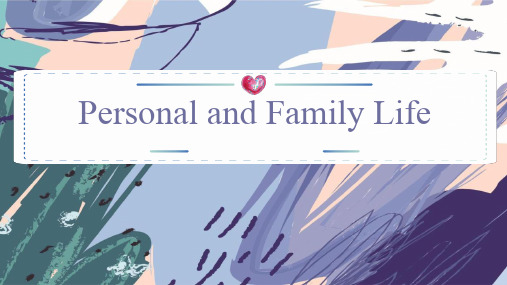
重点详解
1. family name given name Liu Xingting is a flight attendant.
Xinting is her given name. Xu Ming is a firefighter. Xu is his family name.
单词卡片 middle school student
younger sister
twin sisters especially
community
n.初中生 n.妹妹
n.孪生姐妹 adv.尤其是
n.社区
单词卡片 cook
Chongyang Festival handmade
family name delivery person
我的一名消防员,我的妻子是一名教师。
(2)He wants to work as a teacher in Western China. 他想在中国西部当一名教师。
重点详解
4.manage.v动词 manager.n 名词
英译汉: 1.He manages a department. 2.He is a manager.
n.厨师 重阳节 adj.手工的 n.姓 n.送货员
单词卡片 given name flight attendent firefighter vocational ancestor
n.名 n.空乘人员 n. 消防员 adj.职业的
n.祖先
单词卡片 address formal
situation
as for name after
little
三、选择题。
中职英语基础模块上册unit ppt课件
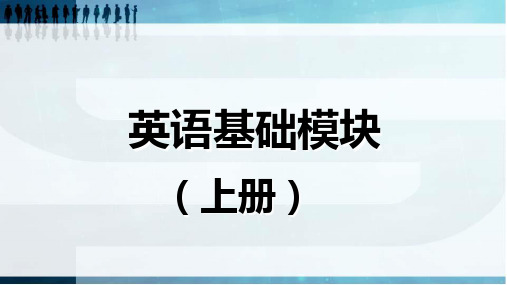
Kissing hands
吻手礼:吻手礼源于古代维京人用手向其日耳曼君 主递礼物的风俗,流行于欧美上层社会,是一种仅对贵 族已婚妇女实施的礼节。吻手礼一般在室内举行,并且 仅限于手腕以下部位,一般是指背。
cross one's
hands 双手合十:
这种礼仪多见于 信奉佛教的国家,比如说泰国。 泰国人见面时往往低头问候, 并将双手合十于胸前。小辈见 长辈双手举到前额高度,平辈 到鼻子高度,而长辈还礼则只 需到胸前即可。另外,泰国认 为头部是神圣的,不能随意摸 别人的头。
你呢
I'm fine,too.Tha
nk you! 我也是,谢谢
LOREM IPSUM DOLOR
Nice to meet you! 很高兴见到你 Nice to meet you,too! 也很高兴见到你
• Notes:
•
• 1. Introductions are important because a proper introduction will leave a good first impression upon others.
•.
Warm-up
Look at the picture and tick. Emily and Jenny meet each other for the first time. Tick what they would say.
( ) 1. Hi, Jenny! ( ) 2. Good morning Jenny. Nice to meet you. ( ) 3. Hello, I’m Emily. ( ) 4. Bye. See you later. ( ) 5. How do you do? ( ) 6. Thank you!
中职英语 基础模块1 Unit 1 Personal and Family Life
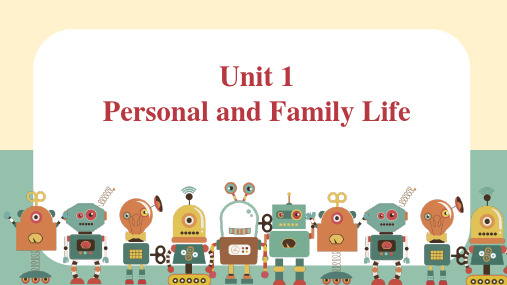
work as a teacher in Star Vocational(职
业的) High School.
记一记:记记交际语
交际语: Hello!My name is ...... . I'm...... . 你好!我的名字是.... 我是...(职业) Hi! My name is ...... . My family name is..... . 你好!我叫....。我姓.....。 Nice to meet you! My first name is... 很高兴见到你!我的名字是....。 Good morning/afternoon/evening! 早安!/午安! / 晚安! How do you do! 你好! I work as.... 我的工作是....
Smith Brown Brown
given name
first name (名字)
family name
last name (姓)
中国是姓在前名在后 西方是名在前姓在后
找一找:找出打招呼的英文表达
1. Hello! my name is Li Ting. I'm a
doctor. my family name is Li.
Words game
点击每个礼物,说出相应单词和释义
doctor
firefighter
delivery person
flight attendant
teacher
1. think and match. 将以下自我介绍与图中人物相匹配
52 3 4 1
1. Hello! my name is Li Ting. I'm a doctor. my family name is Li. 2. Hi! My name is Zhang Yifan. I'm a delivery person. Yi fan is my given name. 3. Nice to meet you! I'm Liu xinting. I'm a flight attendant. How can I help you? 4. Good morning!I'm Xu Ming, a firefighter. My given name is Ming means brightness. 5. Good afternoon! I'm Yu xinling. I work as a teacher in Star Vocational High School.
职高英语基础模块上册-Unit-1-(English)
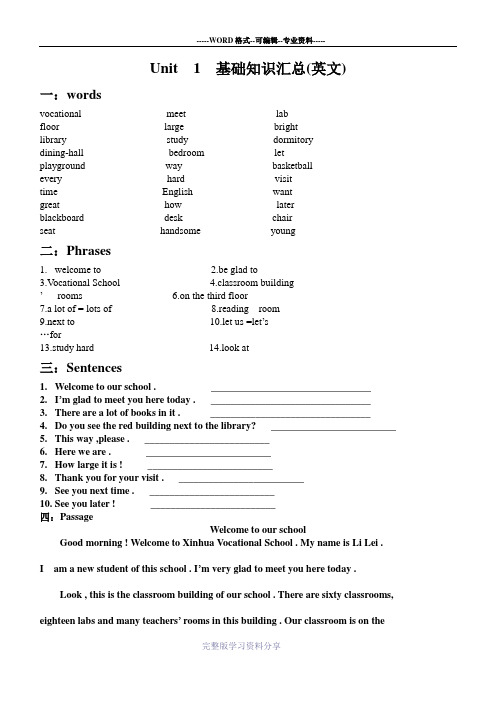
Unit 1 基础知识汇总(英文)一:wordsvocational meet labfloor large brightlibrary study dormitorydining-hall bedroom letplayground way basketballevery hard visittime English wantgreat how laterblackboard desk chairseat handsome young二:Phrases1.welcome to2.be glad to3.V ocational School4.classroom building’rooms 6.on the third floor7.a lot of = lots of 8.reading room9.next to 10.let us =let’s…for13.study hard 14.look at三:Sentences1.Welcome to our school . ________________________________2.I’m glad to meet you here today . ________________________________3.There are a lot of books in it . ________________________________4.Do you see the red building next to the library? _________________________5.This way ,please . _________________________6.Here we are . _________________________7.How large it is ! _________________________8.Thank you for your visit . _________________________9.See you next time . _________________________10.See you later ! _________________________四:PassageWelcome to our schoolGood morning ! Welcome to Xinhua Vocational School . My name is Li Lei .I am a new student of this school . I’m very glad to meet you here today .Look , this is the classroom building of our school . There are sixty classrooms, eighteen labs and many teachers’ rooms in this building . Our classroom is on thethird floor . It is large and bright . There are fifty students in our class . Thatbuilding is the school library .It is a new building . There are a lot of books init .There are four reading rooms in the library .We can read and study in the readingrooms after class . Do you see the red building next to the library ?That is thestudents’ dormitory .There is a large dining-hall and many bedrooms in it .Now let’sgo to the playground of our school .This way , please .Oh, here we are ! How largeit is ! Many students play basketball and football here after class every day .Our school is a very good school . We love our school . We all study hard here .Well, thank you for your visit . See you next time .Complete the blanks :完形填空Welcome to Center Street. Center Street is a great place to enjoy ___ 1 ___ .There are ____ 2 ____ stores and shops on it. It is a very ___ 3 ____ street. If you want to ____ 4 ___ you can go to the video arcade. It is ___ 5 ___ from the big supermarket. There is also a new park ___ 6 ___ the supermarket. It is ___7 ___ and quiet. You can ____8 ___ your picnic(野餐) in it. If you want to see ___9 ___,you can go to the movie house. It is ____10 __ the supermarket and the park.1 B.you2A.lot of B.a lots C.a lot of D.a lot34A.have lunch B.play games C.buy clothes D.see animals5 D. near678910 D.next to阅读理解。
中职英语基础模块上册Unit-2

• ⑹ be popular with 受…的欢迎
• Eg:This singer is popular with young people.
•
这个歌手很受年轻人的欢迎
• On the right of my father stands a handsome Young ma n, tall and thin. He wears a blue T‒shirt and looks rathe r cool. He is my uncle. He is a student at a
• ⑶live with 与…一起生活
• Eg:I live with my family.我与我的家人一起生活
• ⑷ together with连同.......
• Eg: I’ll go shoping together with my friends. 我和我的朋友一起去买东西
• My father stands behind my grandfather. He is forty‒ • five years old. He is a manager at a company and he • is a hardworking man. Behind my grandmother is my m
英语基础模块(上册)
• •How many people are there in your family?
• ----There are
people in my family.
• •Who are they? • ----They are my
and I.
Mother 妈妈/母亲
Father 爸爸/父亲
• How? hard working
中职英语基础模块第一册unit

中职英语基础模块第一册 UnitUnit概览•本单元的主题是介绍个人信息和日常生活。
•学习目标:学习英语中有关个人信息、日程安排、购物以及问路的常用表达方式。
•主要词汇:个人信息、时间、购物、问路等。
1. 个人信息(Introduction)1.1 自我介绍(Self-Introduction)在日常交流中,我们经常需要进行自我介绍。
以下是一些常用的句子:•Hi, my name is [your name]. 你好,我叫[你的名字]。
•Nice to meet you. 很高兴认识你。
•I am [your age] years old. 我今年[你的年龄]岁。
•I come from [your country]. 我来自[你的国家]。
•I am a student/worker. 我是一名学生/工作者。
•My hobbies are [your hobbies]. 我的爱好是[你的爱好]。
•I can speak [languages you speak]. 我会说[你会说的语言]。
1.2 个人信息(Personal Information)在日常生活中,我们会被问到一些个人信息。
以下是一些相关表达方式:•What is your full name? 你的全名是什么?•When is your birthday? 你的生日是什么时候?•Where are you from? 你来自哪里?•What is your phone number? 你的电话号码是多少?•What is your email address? 你的邮箱地址是什么?2. 日程安排(Scheduling)2.1 询问时间(Asking for Time)在日常生活中,我们经常需要询问时间。
以下是一些常用的句子:•What time is it? 现在几点了?•Do you have the time? 请问你能告诉我时间吗?•Could you tell me the time, please? 请问你可以告诉我时间吗?2.2 时间表达(Time Expressions)在安排时间时,我们需要使用一些时间表达方式。
中职英语基础模块上册unit课文 ppt课件

He often fights with his younger sister.
他经常和他妹妹打架。
• give sb. sth: 给某人某物
• 例如: • He gave me a birthday present. • 他给我一个生日礼物。
ppt课件
8
• a bag of: 一包,一袋;
He asked him to pull out one nail each
time when he keep his temper.
ppt课件
24
7) Did the boy pull out all the nails?
Yes ,he did.
8)Then what did his father told the boy?
classmates and frieppnt课件ds.
25
三:Summary(概括 )
fight with others
lose his temper
hammer a nail
keep his temper
pull the nail
get on well with others
ppt课件
26
四.What we should do
• 例如:abowl of; a cup of; a handful of; an armful of;
• He gave me a bag of apples.
• 他给我一袋苹果。
• tell sb to do sth: 告诉某人去做某
事
• 例如:
• Tell him to wait me for a while.
• lead sb to ---
中职英语基础模块上册Unit-2

Match the words in Box A with the words in Box B.
A
• Grandmoth er
• Grandfathe r
• Father • Mother • uncle
B
• teacher • retired worker • manager • student
3)指示代词: 指示说明近处或者远处、上文或 者下文、以前或者现在的人或事物。
• 指示代词既可以单独使用做句子的主语、宾语或表语,也可以 作定语修饰名词。
• 如:
• What’s this?(这是什么?) • That model plane is made of plastic.(那只模型飞机是塑料做的) • (被动句) • Remember never to do such things.(记得永远不要做这样的事情
• ⑹ be popular with 受…的欢迎
• Eg:This singer is popular with young people.
•
这个歌手很受年轻人的欢迎
• On the right of my father stands a handsome Young ma n, tall and thin. He wears a blue T‒shirt and looks rathe r cool. He is my uncle. He is a student at a
中职英语基础模块(上册)unit.pdf

Unit 2 Family(Ⅰ)Teaching aims(教学目的及要求):了解有关家庭成员以及有关职业的词汇掌握询问家庭及职业的句型,练习提高英语口语交际能力 识记本单元的词汇Teaching importance and difficulties(教学重点及难点):询问家庭及职业的句型,提高英语口语交际能力 熟练认读本单元英语词汇Class(课时):1课时Teaching methods(教学方法):情景教学法、合作教学法、分组教学法运用情景教学和分组教学的方法使学生积极参与课堂中有关“家庭及职业”的提问——How many people are there in your family ? who are they? What are they?等, 以及根据实际情况回答“There are people in my family. They are my . ……;当同学回答遇到困难的时候,可以求助同学和老师,在老师同学的帮助下完成提问,提高同学回答问题的积极性。
Teaching aids (教具):准备有关家庭成员的图片;录音机Reference book (参考书):教师用书Teaching procedures(教学过程): Step1——warming up:Describe the members of a family in the picture.we can draw the family tree.Family treenurse/policeman/ engineer …There are They are My isa ;…… Divide into groups to make oral practice with above useful expressions . Step 2——new words and expressions⑴be kind to …“对…和蔼可亲”be friendly to …“对…友好”eg:Our teacher is very kind/friendly to us.⑵enjoy doing …喜爱做…Eg: I enjoy listening to music.enjoy oneself 玩的高兴,过的愉快Eg:Are you enjoying yourself?⑶live with 与…一起生活Eg:I live with my family.⑷ together withEg: I’ll go shoping together with my friends.⑸also adv. 也,同样Eg:He also asked to go.He has made up his mind to go to the countryside, and I also.与too 的区别Eg: I was there and he was there too.还有 as well/either:Eg: I like you as well.I don’t like him either.总结also 用于肯定句的句中too/as well 用于肯定句句尾either 用于否定句句末⑹ be popular with 受…的欢迎Eg:This singer is popular with young people.⑺ on the right/left ofEg: I sit on the right/left of him.⑻be full ofEg: our class is full of love and warmth.Her eyes are full of tears.Step 3——Read the new words and expressions over times folling the tapes.Homework :(分层次作业)1、To remember the new words and expressions.2、To preview the “Family”,complete the Reading Comprehension onpage 12 in textbook.Blackboard design:( 板书设计)Unit 2 Family1、Family treeJobs :Useful expressions:How many people are there in your famiy?There are .Who are they ?They are .What are they?My father is a ;my mother is a ; my brother isa ;……2、new words and expressions⑴be kind to …“对…和蔼可亲”be friendly to …“对…友好”⑵enjoy doing …喜爱做…enjoy oneself 玩的高兴,过的愉快⑶live with 与…一起生活⑷ together with⑸also adv. 也,同样与too 的区别还有 as well/either:总结also 用于肯定句的句中too/as well 用于肯定句句尾either 用于否定句句末⑹ be popular with 受…的欢迎⑺ on the right/left of⑻be full ofTeaching reflection:(教学后记)1、要求每个同学都能按照板书上的交际用语根据实际情况回答问题,提高同学的口语交际能力。
(完整版)中职英语基础模块unit1
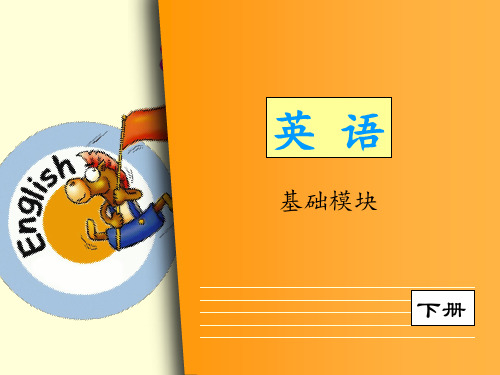
Section B Listening and Speaking
Warm-up
Dialo English Learning
Objectives
1. 能够辨别 /ɔː/ 和/aʊ/,/ɒ/和/əʊ/,/k/和/ɡ/,/j/和/dʒ/的 在句中发音的不同,并能正确掌握其发音。 2. 熟练掌握本单元出现的词汇、短语和句型,并能用 学过的短语、句型谈论英语学习。 3. 熟练掌握一般将来时态的用法。 4. 熟练掌握名片的基本写法。
Group 1 /ɔː/ and /aʊ/
Script (1)My uncle has a horse. (2)They shout at each other.
Group 2 /ɒ/and əʊ/
Script (1) That clock must be fast. (2) Tom wears a red coat today.
Warm-up Here are some sentences related to English learning. Please match them with the corresponding pictures.
5 Little Tom can’t remember new words he has learnt.
Activities
Warm-up Here are some sentences related to English learning. Please match them with the corresponding pictures.
中职英语基础模块((上册))unit_

中职英语基础模块((上册))u n i t_------------------------------------------作者xxxx------------------------------------------日期xxxxUnit 2 Family(Ⅰ)Teaching aims(教学目的及要求):了解有关家庭成员以及有关职业的词汇掌握询问家庭及职业的句型,练习提高英语口语交际能力识记本单元的词汇Teaching importance and difficulties(教学重点及难点):询问家庭及职业的句型,提高英语口语交际能力熟练认读本单元英语词汇Class(课时):1课时Teaching methods(教学方法):情景教学法、合作教学法、分组教学法运用情景教学和分组教学的方法使学生积极参与课堂中有关“家庭及职业”的提问——How many people are there in your family ? who are they? What are they?等,以及根据实际情况回答“There are people in my family. They are my . ……;当同学回答遇到困难的时候,可以求助同学和老师,在老师同学的帮助下完成提问,提高同学回答问题的积极性。
Teaching aids(教具):准备有关家庭成员的图片;录音机Reference book(参考书):教师用书Teaching procedures(教学过程):Step1——warming up:Describe the members of a family in the picture.we can draw the family tree.Family tree复习有关描述职业的词汇:worker/ teacher/ manager/ doctor/ student/ driver/ farmer/ nurse/policeman/ engineer…练习询问有关家庭及家庭成员职业的简单句:How many people are there in your famiy?There are . Who are they ?They are . What are they?My father is a ;my mother is a ; my brother is a ;……Divide into groups to make oral practice with above useful expressions .Step 2——new words and expressions⑴be kind to …“对…和蔼可亲”be friendly to …“对…友好”eg: Our teacher is very kind/friendly to us.⑵enjoy doing …喜爱做…Eg: I enjoy listening to music.enjoy oneself 玩的高兴,过的愉快Eg:Are you enjoying yourself?⑶live with 与…一起生活Eg:I live with my family.⑷ together withEg: I’ll go shoping together with my friends.⑸also adv. 也,同样Eg:He also asked to go.He has made up his mind to go to the countryside, and I also.与too 的区别Eg: I was there and he was there too.还有 as well/either:Eg: I like you as well.I don’t like him either.总结also 用于肯定句的句中too/as well 用于肯定句句尾either 用于否定句句末⑹ be popular with 受…的欢迎Eg:This singer is popular with young people.⑺ on the right/left ofEg: I sit on the right/left of him.⑻be full ofEg: our class is full of love and warmth.Her eyes are full of tears.Step 3——Read the new words and expressions over times folling the tapes.Homework :(分层次作业)1、To remember the new words and expressions.2、To preview the “Family”,complete the Reading Comprehension onpage 12 in textbook.Blackboard design:( 板书设计)Unit 2 Family1、Family treeJobs :Useful expressions:How many people are there in your famiy?There are .Who are they ?They are .What are they?My father is a ;my mother is a ; my brother is a ;……2、new words and expressions⑴be kind to …“对…和蔼可亲”be friendly to …“对…友好”⑵enjoy doing …喜爱做…enjoy oneself 玩的高兴,过的愉快⑶live with 与…一起生活⑷ together with⑸also adv. 也,同样与too 的区别还有 as well/either:总结also 用于肯定句的句中too/as well 用于肯定句句尾either 用于否定句句末⑹ be popular with 受…的欢迎⑺ on the right/left of⑻be full ofTeaching reflection:(教学后记)1、要求每个同学都能按照板书上的交际用语根据实际情况回答问题,提高同学的口语交际能力。
中职英语基础模块上册 Unit3 Campus Life
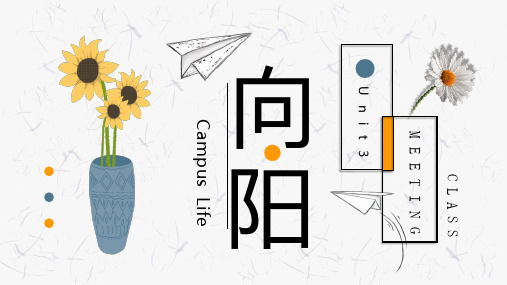
虚词 (意义不完整,不能独立 作句子成分的词)
“名代动→数形副→介冠连感”
friend with
kind adj.和蔼的,亲切的
kindness n.和蔼,友善
be kind to 对……和蔼可亲的
It’s kind of sb. to do sth. ……对某人来说太仁慈了
Eg. (1) The teacher is kind to all of us.
(2) It’s kind ___ me.
The young man always shows off his brand coats.
那个年轻人总是炫耀他的名牌外套
(1) with the help of 在……的帮助下
Eg: With the help of my sister, I finished
my novel.
在我姐姐的帮助下我完成了我的小说
bus
buses
map maps
class classes
potato potatoes
student students
desk desks
woman women
family families
teacher teachers
orange oranges
leaf
leaves
watch watche . city scities . day days . knife knives .
中职英语 基础模块上册 Unit 1 Greetings warming up
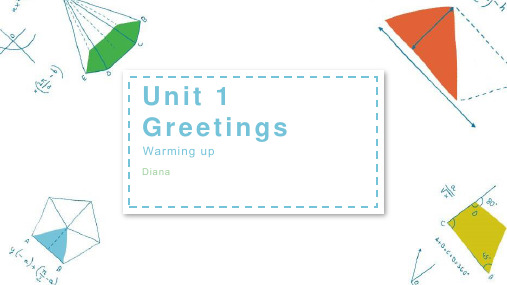
Thank you
Unit 1 Greetings
Warming up
Diana
Key word
• Greetings [ˈɡriːtɪŋz] 问候;打招呼;问候语 Eg:
发送贺卡 send greeting cards They exchanged greetings. 他们互相问候。 What are the general phrases used for greetings morning,day and evening? 早上、中午和傍晚,最常见的问候语是什么? (Answer)
0
Greetings 询问近况:最近过得怎么样?
How do you do?(正式) How are you?(礼貌) How is it going?(随意) How are you doing(随意) —— Pretty good. 过得非常好。 ——Fine,thank you. 很好,谢谢。 ——Not so well. 过得不太好。 What's up? (随意) —— Nothing much./ What's up.
0
Greetings
•
你是不是只会是不是只会回应I‘m fine.Thank you. And you?
• 那我猜“再见”你也只会说“Goodbye”喽?
0
Greetings 打招呼
Hello! Hi! Hey! Hi,there! 你好(不是特别熟悉的人) Good morning! Good afternoon! Good evening! Good night!
0
Greetings 回答问候
Pretty good. 过得非常好。 Fine,thank you. 很好,谢谢。 Not so well. 过得不太好。
中职英语基础模块第一册unit

中职英语基础模块第一册unit1. Introduction to UnitThe first unit of the vocational English basic module introduces students to the fundamentals of the English language. This unit serves as a foundation for the subsequent modules, laying the groundwork for essential language skills and knowledge. The unit aims to assist students in developing basic communication skills, understanding grammar structures, expanding vocabulary, and improving listening and reading comprehension abilities.2. Unit ObjectivesThe objectives of this unit are as follows:•To introduce students to basic English grammar structures•To expand students’ vocabulary related to everyday life and common topics•To enhance students’ listening and reading comprehension skills•To develop students’ skills i n basic communication and conversation3. Lesson 1: Greetings and IntroductionsIn the first lesson of Unit 1, students are introduced to common greetings and introductions in English. The lesson focuses on essential phrases and polite expressions used in different social contexts. Students will practice verbal and written exercises, engaging in role plays and dialogues to reinforce vocabulary andexpressions. The aim is to ensure that students are able to confidently greet and introduce themselves in various situations.4. Lesson 2: Numbers and DatesLesson 2 covers numbers and dates in English. Students will learn how to count and pronounce numbers, both cardinal and ordinal, from one to one hundred. Additionally, they will become familiar with different ways of expressing dates, including the day, month, and year format. The lesson includes interactive exercises to reinforce comprehension and practical applications of numbers and dates.5. Lesson 3: Family and RelationshipsIn Lesson 3, students learn vocabulary related to family and relationships in English. They will acquire the vocabulary necessary to describe family members, as well as phrases used to discuss relationships and personal connections. The lesson encourages students to engage in discussions about their own families and relationships, providing practical application of the vocabulary in real-life situations.6. Lesson 4: Daily RoutinesThis lesson focuses on daily routines. Students will learn vocabulary and expressions related to activities in their daily lives. They will practice discussing their daily routines and schedules, as well as forming sentences using appropriate verb tenses. The lesson incorporates various listening exercises and interactive activities to enhance understanding and usage of daily routine vocabulary and phrases.7. Lesson 5: Asking for and Giving DirectionsLesson 5 introduces students to vocabulary and phrases used when asking for and giving directions in English. Students will learn how to ask for and give various types of directions, such as asking for directions to a place or providing directions on a map. They will engage in role plays and practical exercises to reinforce their ability to understand and communicate directions effectively.8. Lesson 6: Time Expressions and AdverbsThe final lesson of this unit covers time expressions and adverbs. Students will learn to express specific times and durations using appropriate vocabulary and adverbial phrases. They will engage in listening exercises and writing tasks to reinforce their understanding and usage of time expressions and adverbs in context.9. ConclusionUnit 1 of the vocational English basic module provides students with a solid foundation in English language skills. By focusing on greetings, introductions, numbers, dates, family, daily routines, directions, and time expressions, students will develop essential communication skills necessary for various real-life situations. The unit aims to build students’ confidence in their ability to understand and use English in a vocational context.。
中职英语基础模块上册 unit 1 greetings——welcome to our school
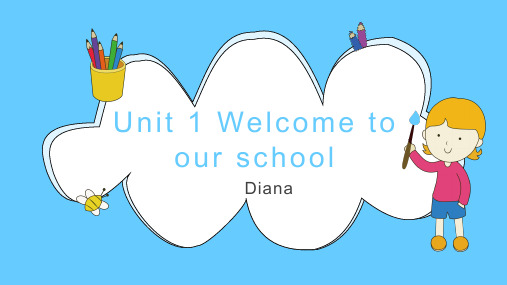
Homework 1.作业本上总结所讲的单词(单词+释义) 2.课本上P3选词填空。 3.背过所讲单词,下次课听写。
Thank you!
与学校相关的单词
• vocational [vəʊˈkeɪʃənl] adj.职业的 vocation[vəʊˈkeɪʃn] n.职业
Eg:欢迎来到
职业 教育 学校。
Welcome to
vocational education school.
与学校相关的单词
class班级,课节 • classroom 教室
与学校相关的单词
• dormitory [ˈdɔ:mitri] 宿舍? bedroom 卧室,寝室
•dining-hall ['daɪnɪŋh'ɔ:l]餐厅
•playgry basketball/football on the playground every day.
与学校相关的单词
chair 椅子 seat 座位 • library[ˈlaɪbrəri] 图书馆
Eg:图书馆里有很多书。 There are a lot of books in the library.
•reading room 阅览室 Eg:下课后,我们经常在阅览室里学习。 After class,we often study in the reading room.
• glad 高兴的 meet 遇见、汇合、迎接 nice 好的、令人愉快的
be glad to do 很高兴做... I'm glad to meet you. Nice to meet you.
• thank 感谢
thank...for... 为...而感谢... Thank you for your visit(参观)
- 1、下载文档前请自行甄别文档内容的完整性,平台不提供额外的编辑、内容补充、找答案等附加服务。
- 2、"仅部分预览"的文档,不可在线预览部分如存在完整性等问题,可反馈申请退款(可完整预览的文档不适用该条件!)。
- 3、如文档侵犯您的权益,请联系客服反馈,我们会尽快为您处理(人工客服工作时间:9:00-18:30)。
He said, “You have done well, son, but look at the holes in the fence. The fence will never be the same as it was before . When you say some words in anger, your bad temper will leave a scar just like the hole.
unit 9 Cultivation
教养、修养
1.What will you do to make your friends smile and feel happy? 你会做什么让你的朋友微笑和感到快乐?
2.Do you sometimes lose your temper when you are in trouble? 当你遇到麻烦的时候,你是否也会发脾气?
3.Why did the boy stop driving the nails into the fence later?
Because the boy didn't lose his temper at all . 4.What did the father ask him to do each time he
他说:“你做得很好,孩子,但看看篱笆上的洞。篱
笆永远不会和以前一样。当你生气地说几句话时,你
的坏脾气就会像洞一样留下疤痕。
Even if you say you’re sorry, the wound is still there. If you hurt a person with words, the wound is as bad as a physical one. Friends are rare jewels. They make you smile and feel happy. So never hurt your friends.”
3.How can you get on well with others? 你怎么能和别人相处得好?
There was once a little boy with a bad temper. He often had fights with his friends.
从前有个小男孩脾气不好,他经常和朋友打架
即使你说对不起,伤痕还在那里。如果你伤害一个人的话
,造成的伤痕和身体上是一样的。朋友是稀世珍宝。他们
让你笑,感到快乐。所以永远不要伤害你的朋友。”
Since then the boy had never fought with his friends. He learned how to get on with others and he never lost his temper again.
One day,his father gave him a bag of nails and told him to hammer a nail into the fence every time he lost his temper. The boy listened to his father and did what his father told him to do .
从那以后,男孩就再也没有和朋友打架了。他学会了如
何与别人相处,而且从不发脾气。
1.What did the father ask the little boy to do each
time he lost his temper?
The father asked his son to hammer a nail into .
the fence every time he lost his
.
2.How many nails did thetbeomyphearmmer into the
fence the firsrt day?
The first day, the boy drove 17 nail into the fence .
有一天,他的父亲给了他一袋钉子,告诉他每次他发脾气
的时候都要把钉子钉进栅栏里。男ቤተ መጻሕፍቲ ባይዱ听了他父亲的话做了
他父亲叫他做的事
The first day, the boy drove 17 nails into the fence. Then the number of nails became less and less in the following days. The boy found that it was easier to keep his temper than to drive the nails into the fence.
终于有一天,男孩没有发脾气。他告诉父亲这件事,他父 亲要求他每次发脾气时都要拔出一个钉子。
The days passed and the young boy was finally able to tell his father that all the nails were gone. The father took his son by the hand and led him to the fence .
was able to keep his temper? The father asked his son to pull out one nail each time he was able to keep his temper .
第一天,男孩把17根钉子插进栅栏。接下来的日子里钉子 的数量越来越少。这个男孩发现保持脾气比钉钉子更容易
Finally, the day came when the boy didn’t lose his temper at all. He told his father about it and his father asked him to pull out one nail each time he was able to keep his temper.
